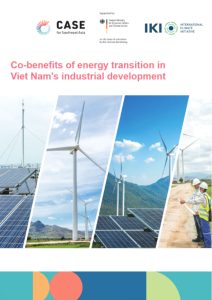The study on “Co-benefits of energy transition in Viet Nam’s industrial development” aims to provide an overview of the localisation of the industrial sector amid the energy transition. It examines various aspects, including policy framework, international experience, current status and the localisation potential of two key technologies: wind and solar power in the period 2025- 2050. On the other hand, this study also serves as a foundation for GIZ to conduct more detailed and in-depth policy framework research for localisation in the next stages.
Research results show that in general, the total market potential of wind and solar power technologies across the three stages of project development, manufacturing, installation/ construction in the period 2025-2050 is estimated at nearly USD 160 billion (at 2023 curent prices), accounting for 1.02% of Viet Nam’s Gross Domestic Product
(GDP) of the entire period. This figure is roughly equal to the 2022 GDP contribution at current prices of the Industry and Construction sector, with a value of USD 155 billion. Of which, the market potential of offshore wind accounts for the largest proportion of 51.8% (USD 82.5 billion), followed by onshore wind (24.3%) and solar (24%).

The average local content for solar power is approximately 45% at present and is projected to increase to nearly 78% by 2050. For wind power, the localisation rate is 37% at the current time and is anticipated to reach 54% by 2050. During the entire 2025-2050 period, the localised value of wind and solar power technologies in the three aforementioned project stages is projected to reach nearly USD 80 billion, accounting for 50% of the total market potential for these two technologies. Although the current average local content of solar power is higher than that of wind power, the localisation of solar power mainly focuses on stages with low cost share in the investment unit cost, whereas the production stage for solar panel, which on average takes up a relatively high percentage of costs at about 55%, has a low local content level due to competition with imported products from China.
Promoting localisation will bring certain benefits, however, localisation policy also faces challenges such as (1) Clearly defining how much localisation is reasonable and designing a roadmap to achieve that goal, (2) Insufficient investment and low technological capability have become significant challenges for Vietnamese enterprises engaging in supporting industries, (3) The localisation targets has not been integrated into FDI attraction policies.
In addition, there are challenges in transitioning jobs from the current labour market to a highskilled labour market, especially in the context where multinational corporations implement supply chain strategies that involve multiple support suppliers, as seen with companies like Samsung, Toyota, Intel, etc.
To maximise the benefits and minimise the challenges of localisation, a number of policy proposals should be considered:
- Integrating co-benefits of energy transition into legal system and policy impact assessment processes. Early co-benefit assessment should be conducted as soon as possible to provide inputs from the policy formulation stage to ensure comprehensiveness and optimal policy decisions.
- Determining the socio-economic development targets of the energy transition trend through local content targets: One of the potential benefits of local content requirements is the opportunities it provides for domestic enterprises to learn by doing and to promote innovation. Prioritising the localisation of the stages of project development, installation/ construction, and manufacturing of equipment that Viet Nam currently has strengths in, such as substations, cables, towers, mounting structures, etc. This is especially instrumental in the context of integrating international RE supply chains with high entry barriers. In this context, Viet Nam will need to thoroughly break down current market conditions and existing value chains in order to develop appropriate local content targets for different periods.
- Increasing local value through human resource development: Viet Nam has established effective “demand pull” policies, including FIT, rooftop solar power development supporting policies, etc. However, the “supply push” measures have not yet been implemented strategically due to the conditions available at the time. Viet Nam’s value creation can be promoted by combining product R&D with human resource training and development of domestic service providers. This will also help reduce the dependence on foreign experts. Furthermore, Viet Nam can provide skilled engineers to other countries in the region.
Limitations of the study: Due to time and resource constraints, the study has certain limitations. For example, the quantity and volume of survey samples are still modest, at the same time, the project development, equipment manufacturing, and construction stages in the value chain have not yet been dissected at deeper levels. Further in-depth research on the localisation of the wind and solar power industry in the next period is required to inform a policy framework and detailed roadmap that will maximise the benefits and mitigate the risks of localisation, and carefully consider these limitations when applying the results to the real contexts.
Link to Further Materials
- Co-benefits of energy transition in Viet Nam’s industrial development – CASE for Southeast Asia (caseforsea.org)
- Co-benefits of energy transition in Viet Nam’s industrial development – ESP (gizenergy.org.vn)
- https://gizenergy.org.vn/vi/item-detail/dong-loi-ich-cua-chuyen-dich-nang-luong-trong-phat-trien-cong-nghiep-viet-nam/
Contact Person
Vu Chi Mai
Key Buzzwords
Co-benefits, localisation, project development, manufacturing, installation, construction, Viet Nam
